|
|
|
Sort Order |
|
|
|
Items / Page
|
|
|
|
|
|
|
| Srl | Item |
| 1 |
ID:
164609
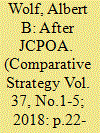

|
|
|
|
|
| Summary/Abstract |
If grand strategy is a state's theory of how to produce security for itself, what should the U.S. grand strategy be toward Iran? This is an important question that has only grown since the Trump administration announced it would not recertify Iran under the Joint Comprehensive Plan of Action (JCPOA). This article lays out four options: rollback, offshore balancing, retrenchment, and engagement. Each strategy has its merits as well as its drawbacks.
|
|
|
|
|
|
|
|
|
|
|
|
|
|
|
|
| 2 |
ID:
164630


|
|
|
|
|
| Summary/Abstract |
This article assesses the relevance of US seapower in the contemporary security environment. This paper builds upon a rich literature on sea power, strategy, and maritime operations to assess recent factors and emerging geostrategic dynamics that are likely to affect American maritime strategy, while keeping sight of the principles that will endure regardless of shifting domestic and international politics. It places the application of sea power in an historic and strategic context to inform the policy choices that confront the administration in wielding elements of national power to further U.S. interests around the world. These issues come to the fore as the Trump Administration is seeking to expand the size of the Navy, with various proposals to increase the number of ships in the fleet to 350 vessels. The article presents these issues to highlight the building blocks available and the challenges faced by the United States as it seeks to reinvigorate its maritime strategy in the 21st century.
|
|
|
|
|
|
|
|
|
|
|
|
|
|
|
|
| 3 |
ID:
164624


|
|
|
|
|
| Summary/Abstract |
Arab Gulf countries have been trying to set up a local defense industrial base for decades. Recently, these efforts have become much more serious due to a changing geostrategic context, local transformation, and the striving for a more active foreign policy role beyond the region. Today's Arab Gulf defense pivot rests on four pillars: broadening the traditional defense-supplier base; establishing indigenous defense industries; setting up a defense-industrial network within and beyond the region; enlarging foreign policy clout by way of defense exports, defense-material donations, and third-country defense funding. Despite progress, challenges regarding strategic and financial stability and local skill sets remain.
|
|
|
|
|
|
|
|
|
|
|
|
|
|
|
|
| 4 |
ID:
164621
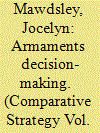

|
|
|
|
|
| Summary/Abstract |
When states make decisions on armaments policy, it is generally agreed they try to achieve combinations of foreign, security, industrial, economic, and technological policy goals alongside equipping their armed forces as efficiently as possible. It is, however, consistently argued in both the defense-economics and EU-studies literature that for European states things are (or should be) different. This article contributes to this debate by bringing together these disparate literatures to critically examine the proposition that the existence of a semi-regionalized European defense economy fundamentally changes state calculations on armaments policy. It critically examines the two main claims made about behavioral change: that European states accept a liberalized European defense market governed by the EU and make armaments decisions on a value-for-money basis, or that defense interdependence is so advanced that European states no longer need to consider their national interests because these are subsumed in the European interest. The article then considers an alternative perspective, that state behavior has not changed but is restricted by the existence of a European defense market that, intentionally or not, works to protect the interests of the biggest European arms-producing states.
|
|
|
|
|
|
|
|
|
|
|
|
|
|
|
|
| 5 |
ID:
164632
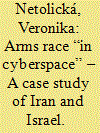

|
|
|
|
|
| Summary/Abstract |
The article focuses on the area of cyber security, specifically on the theory of arms race in cyberspace, which is applied to case study of Iran and Israel. The first part describes the evolution of arms race in conventional environment with link to cyberspace. In the second part, the article focuses on description of selected indicators that prove/disprove the arms race in cyberspace in the relationship between selected dyad. In conclusion, the summary presents not only the selected states but also debates the overall usability of the concept of arms race in cyberspace in its general use for further research.
|
|
|
|
|
|
|
|
|
|
|
|
|
|
|
|
| 6 |
ID:
164616
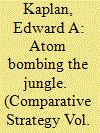

|
|
|
|
|
| Summary/Abstract |
In 1960, the senior Air Force officer in Europe published an article in the Air Force's premier journal in which he advocated using nuclear weapons to combat insurgency. His ideas, as outlandish as they sound to modern ears, were consistent with a belief that a nuclear-armed military designed to flatten a superpower could ably handle lesser contingencies. While most of the theoretical exploration of using America's “best” weapons was in the realm of limited war against major powers, some of that thinking was dedicated to small wars. This article focuses on how the air-atomic USAF envisioned using nuclear weapons in small conflicts against minor powers or insurgencies. The Air Force of the mid- to late-1950s sought solutions to problems using its existing doctrine and equipment. It depended on blunt (nuclear) force delivered by manned aircraft operating independently of ground forces, the USAF struggled with emerging trends in conventional and unconventional warfare, but had confidence it could handle the challenge. As one airpower thinker of the period stated, “The dog we keep to lick the cat can lick the kittens too.”
|
|
|
|
|
|
|
|
|
|
|
|
|
|
|
|
| 7 |
ID:
164627


|
|
|
|
|
| Summary/Abstract |
Brazil is reformatting its domestic defense industry. In the last three decades, Brazil has seen its defense industry go through a number of different phases: from being vibrant and export oriented in the 1980s, to a stagnant industry in the 1990s, with a resurgence in the 2000s. In the past three decades, Brazil built a dynamic and diversified defense industry. Successions of domestic political and economic policies, and international trends, have relegated Brazil’s once-emerging defense industry to a marginal position in the global defense industry. This article analyzes future prospects, challenges, and growth strategies for Brazil’s defense industry.
|
|
|
|
|
|
|
|
|
|
|
|
|
|
|
|
| 8 |
ID:
164608
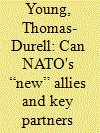

|
|
|
|
|
| Summary/Abstract |
This article posits that most postcommunist members of NATO and key partners continue the practice of using communist concepts of command at the national level of governance. These concepts include the hyper-centralization of decision making, collective decision making, and of most concern, unclear chains of command and alignment of authority with responsibility. Combined, these concepts have the potential for inhibiting the timely and clear command of a nation's armed forces, let alone their effective assimilation into the alliance's integrated command structure. Such an eventuality has clearly negative implications for the alliance generally, but these weaknesses also could have the unexpected consequence of compromising “new” allies' national sovereignty in crisis and war.
|
|
|
|
|
|
|
|
|
|
|
|
|
|
|
|
| 9 |
ID:
164629


|
|
|
|
|
| Summary/Abstract |
This article examines the intersection of the evolving Chinese command, control, communications, computers, intelligence, surveillance, and reconnaissance (C4ISR) military paradigm, with the cyber, space, and electronic warfare asymmetric challenges posed to the U.S. on the future network-centric battlefield. In contrast to China’s conventional weapon systems, far less ink has been spilled on Chinese thinking in the development of the critical support architecture, which enables and enhances China’s war-fighting capabilities. A central argument this article makes is that the technologically advanced offensive weapons fused by C4ISR systems, pose greater threats to the U.S. than the sum of their parts. The destabilizing dynamics emerging in the Asia-Pacific will likely increase the incentives for both sides to strike first, and preemptively against the others C4ISR systems.
|
|
|
|
|
|
|
|
|
|
|
|
|
|
|
|
| 10 |
ID:
164637
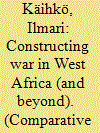

|
|
|
|
|
| Summary/Abstract |
This article investigates the variation of the conduct of war in three Mano River countries in West Africa – Côte d’Ivoire, Liberia and Sierra Leone. A theoretical framework that views war as an institution is provided to explain this variation. While an existing idea in social sciences, to date it has largely been used to understand historical case. This article extends its scope to encompass non-state actors and the modern era through an account of how war was constructed in the Mano River region. The idea of war as an institution highlights the value of cultural sociological investigations of war. As institutions structure action, the framework offered carries immediate consequences for strategic thought.
|
|
|
|
|
|
|
|
|
|
|
|
|
|
|
|
| 11 |
ID:
164620


|
|
|
|
|
| Summary/Abstract |
This article explores the emerging currency battlefield and asks how cyber warfare capabilities influence the nature and conduct of currency warfare, defined as the use of monetary or military force directed against an enemy’s monetary power as part of a military campaign. Currency warfare is not new to war, but recent conflicts such as the ongoing war against ISIS (2014–present), the Russo-Ukrainian crisis (2014–present), and the Russo-Georgian War (2008) indicate a new method of attacking an enemy’s monetary power through cyber capabilities. However, little attention is currently being devoted to how cyber warfare informs the conduct of currency warfare at the strategic, operational, and tactical levels. This article approaches the question from the perspective of currency warfare and argues that cyber warfare’s contribution is at the tactical level, providing a new means by which to target an enemy’s monetary power, but it has not altered the strategic and operational objectives. At the strategic level, currency warfare continues to be motivated by a strategy of subversion and at the operation level, the objective remains the same, the denying of an opponent’s war-financing ability and the enemy leadership’s legitimacy.
|
|
|
|
|
|
|
|
|
|
|
|
|
|
|
|
| 12 |
ID:
164626


|
|
|
|
|
| Summary/Abstract |
This article analyzes contrasting approaches to defense modernization in the Latin American region focusing on Brazil, Chile, Colombia, and Argentina. Three variables of autonomy, spending, and integration highlight the tradeoffs in each country’s strategy while facing the pressure of rising costs of technologically sophisticated systems. We show that these countries’ responses to the defense trilemma between autonomy, technology, and economic sustainability differ according to geographic, economic, and political conditions. Finally, we suggest that regional cooperation in this field is one possible response to the trilemma.
|
|
|
|
|
|
|
|
|
|
|
|
|
|
|
|
| 13 |
ID:
164622


|
|
|
|
|
| Summary/Abstract |
Small arms-producing countries on the global market and especially within NATO and the EU offer important insights into the selection of viable defense-industrial strategies. In two separate eras, Czechoslovakia was among the top three (1920s) or top ten (1980s) largest arms producers in the world. As successor states, the Czech and Slovak Republics have approached the transformation of their defense industrial sectors in dissimilar fashions, leading both through two extremely turbulent decades. The past few years have witnessed a renewed dedication of both countries to the defense sector. This article offers a comparative study of state policy developments in support of the sector, procurement practices, cooperation, and export considerations, relating said aspects to foreign policy. Special attention is dedicated to collaboration initiatives and the maneuvering of both countries within the bilateral, regional, European, and global defense economies.
|
|
|
|
|
|
|
|
|
|
|
|
|
|
|
|
| 14 |
ID:
164618


|
|
|
|
|
| Summary/Abstract |
This article argues that because the EU is more concerned with Turkey serving as a barrier to those seeking refuge in Europe, it has empowered the Erdoğan regime to continue to adopt and implement measures that undermine Turkish democracy. Such a myopic approach has allowed Erdoğan to usurp more power, which has had dire consequences for European security as it means that Europe would share a border a with a nondemocratic state. It also makes it harder for the EU to work with Ankara, because if the EU criticizes or imposes sanctions it makes it more likely that Erdoğan would gravitate toward Russia and Iran, thus further undermining European security, as the EU has a complex relationship with these two countries, particularly Russia. It is only by taking some tough decisions on migration that the EU could solve the insecurity challenge that Turkey poses.
|
|
|
|
|
|
|
|
|
|
|
|
|
|
|
|
| 15 |
ID:
164614
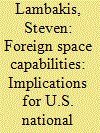

|
|
|
| 16 |
ID:
164611
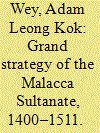

|
|
|
|
|
| Summary/Abstract |
The Malacca Sultanate had profound political and strategic influence in the Southeast Asia region. This article analyzes how the Malacca Sultanate practised its grand strategy using diplomacy and statecraft aided by its military power in countering and containing its external threats to sustain its power, gain economic dividends, and influence in the region. Although there are a few academic studies on the practice of grand strategies such as those of the Roman and Ottoman Empires, none has analyzed the grand strategy of the Malacca Sultanate. The lessons from the historical practice of grand strategy by the Malacca Sultanate generated by this research provides valuable insights and guidance for today's strategic practitioners and policy makers in facing similar security risks in the same geographical setting.
|
|
|
|
|
|
|
|
|
|
|
|
|
|
|
|
| 17 |
ID:
164610


|
|
|
|
|
| Summary/Abstract |
States and non-state actors increasingly use norms instrumentally as integral parts of strategies to help win wars by exploiting political vulnerabilities produced by other actors' adherence to the norms. Actors especially manipulate reactions to violations of casualty-aversion norms to entice or prevent external interventions in conflicts. States have few defenses against the instrumental manipulation of norms they hold dear, and seem largely oblivious to their normative vulnerabilities. High success rates and the continuing proliferation of human rights mean new types of instrumental uses of norms for new purposes are likely to emerge, posing major practical challenges to policymakers, military personnel, and intelligence services, and theoretical challenges for scholars.
|
|
|
|
|
|
|
|
|
|
|
|
|
|
|
|
| 18 |
ID:
164619


|
|
|
|
|
| Summary/Abstract |
Kenya embarked on its first foreign military operation in 2011–2012: Operation Linda Nchi (Protect the Nation) involved operations in Somalia targeting al-Shabaab. Kenya has long been an economic and political bastion of Western support. Moreover, Kenya’s military, the Kenya Defence Forces (KDF), has been a recipient of much Western arms, aid, and training over the years. But how effective were KDF counterinsurgency operations, particularly its use of air power against al-Shabaab? Through a detailed case study, it will become clear that Operation Linda Nchi was poorly planned and the KDF, ill-prepared for its war against al-Shabaab.
|
|
|
|
|
|
|
|
|
|
|
|
|
|
|
|
| 19 |
ID:
164635
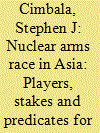

|
|
|
|
|
| Summary/Abstract |
North Korea’s unpredictable behavior with respect to its nuclear arsenal is only one element of a nuclear arms competition among powers in Asia. Nuclear Asia is a potential cockpit for an outbreak of accidental nuclear war or deliberate nuclear first use, as among regional rivals and adversaries. In addition, a limited nuclear war between regional enemies could ignite intervention by outside powers and intensify, in terms of its potential for horizontal or vertical escalation. Research does not support a definitive relationship between the numbers of nuclear weapons states acting in Asia or in the Pacific and the probability of war, including nuclear war. On the other hand, the availability of nuclear weapons may make more states risk acceptant instead of risk averse in regional conflicts, and overconfident with respect to their skills in managing escalation. That finding is important because states’ abilities to manage escalation may be more important than the sizes of their arsenals.
|
|
|
|
|
|
|
|
|
|
|
|
|
|
|
|
| 20 |
ID:
164607
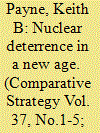

|
|
|
|
|
| Summary/Abstract |
For over two decades since the end of the Cold War, US nuclear policy has been based on a general belief that nuclear deterrence, and thus also nuclear weapons, are of rapidly declining value because international relations had moved toward a much more benign and enduring stage of history. Nuclear weapons supposedly had little or no remaining role to play in US security; the only real questions were how, and how quickly could the United States lead the world to nuclear disarmament. The end of the Cold War, which left the United States as the only standing Superpower inspired this view of history, nuclear deterrence, and nuclear weapons. With the nuclear resurgence of Russia, the rise of China, the mounting nuclear threats from North Korea and potentially Iran, that foundational belief underlying US inattention to its nuclear arsenal is now a manifest fiction, and US nuclear policy must confront, and adjust to a very different reality.
|
|
|
|
|
|
|
|
|
|
|
|
|
|
|
|
|
|
|
|
|